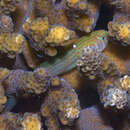en
names in breadcrumbs


The Broad-barred Goby (Gobiodon histrio) is found in the Indo-West Pacific from the Red Sea to Samoa, north to southern Japan and south to the Great Barrier Reef off eastern Australia (Lieske and Myers 2001).
Gobiodon gobies are among the most habitat-specialized fishes on coral reefs, living among the branches of scleratinian corals (stony corals) and having specific associations with one or more species of coral, mostly from the genus Acropora. In a study in Papua New Guinea, the Broad-barred Goby was observed in corals belonging to a number of different Acropora species, but only A. nasuta was actively favored, i.e., used more frequently than expected based simply on its availability. (Munday 2000)Different Acropora species were favored in the Gulf of Aqaba in the northern Red Sea (Dirnwöber and Herler 2007). On the Great Barrier Reef in Australia, where there are two color morphs of A. nasuta, Broad-barred Gobies usually inhabit colonies of the "blue-tip" morph and only rarely the "brown-tip" morph, although these color forms seem truly to be members of the same species (Mackenzie et al. 2004).
In their investigations in the Gulf of Aqaba, Wall and Herler (2008) found that each coral colony is typically occupied by a single breeding pair of Broad-barred Gobies. Only very rarely do juveniles share colonies with adult fishes. Gobies may switch corals in their search for optimal breeding habitat or mates. Breeding pairs exhibit higher home-coral fidelity. (Wall and Herler 2008 and references therein)
Broad-barred Gobies rarely leave the shelter of their host coral colony. However, oxygen levels in this environment can drop very low and at very low tide the entire coral can be exposed to the air. The high tolerance of Broad-barred Gobies for hypoxia and their limited ability to obtain oxygen even when exposed to the air may be essential adaptations for their lifestyle. (Nilsson et al. 2004)
Broad-barred Gobies are among the substantial fraction of coral reef fishes that can change sex in the course of their lives. Although most fish species in which individuals change their sex in the course of their lifetime change in just one direction, i.e., either from female to male (protogyny) or male to female (protandry), in some species, including the Broad-barred Goby, sex can change in either direction (Kroon et al. 2003).
Dixson and Hay (2012) documented a remarkable mutualistic relationship between a coral, Acropora nasuta, and the Broad-barred Goby. These gobies are recruited by the coral to keep it free of the green filamentous macroalga Turtleweed (Chlorodesmis fastigiata), which can harm the coral. Within minutes of Turtleweed (or even a chemical extract from the Turtleweed) contacting the coral, the coral releases an odor that recruits gobies to snack on the Turtleweed and dramatically reduce coral damage that would otherwise occur. Broad-barred Gobies normally produces toxic skin secretions that repel predators and contact with the Turtleweed appears to increase their toxicity.
Dixson and Hay (2012) documented a remarkable mutualistic relationship between the Broad-barred Goby and the coral Acropora nasuta. Broad-barred Gobies are recruited by the coral to keep it free of the green filamentous macroalga Turtleweed (Chlorodesmis fastigiata), which can harm the coral. Within minutes of Turtleweed (or even a chemical extract from the Turtleweed) contacting the coral, the coral releases an odor that recruits gobies to snack on the Turtleweed and dramatically reduce coral damage that would otherwise occur. Broad-barred Gobies normally produces toxic skin secretions that repel predators and contact with the Turtleweed appears to increase their toxicity.
Gobiodon histrio, the Broad-barred goby, is a species of goby native to the Indian Ocean from the Red Sea to the western Pacific Ocean to southern Japan, Samoa and the Great Barrier Reef. This species is a reef dweller, being found at depths of from 2 to 15 metres (6.6 to 49.2 ft). It can reach a length of 3.5 centimetres (1.4 in) TL. This species can also be found in the aquarium trade.[3]
This fish produces a toxin that deters predators. When disturbed, it releases compounds that inhibit the locomotion of other fish. At high enough concentrations, the toxin causes the predator to lose equilibrium and tip over.[4][5] It takes part in a mutualistic relationship with a species of coral, Acropora nasuta. When the coral is damaged by toxic Chlorodesmis algae, it produces a compound that attracts the fish. The fish eat the alga and this enhances their toxicity.[5]
G. histrio can change sex in either direction. When a pair of gobies of the same sex colonize a new coral patch, one of them changes to the opposite sex.[6][7]
Gobiodon histrio, the Broad-barred goby, is a species of goby native to the Indian Ocean from the Red Sea to the western Pacific Ocean to southern Japan, Samoa and the Great Barrier Reef. This species is a reef dweller, being found at depths of from 2 to 15 metres (6.6 to 49.2 ft). It can reach a length of 3.5 centimetres (1.4 in) TL. This species can also be found in the aquarium trade.
This fish produces a toxin that deters predators. When disturbed, it releases compounds that inhibit the locomotion of other fish. At high enough concentrations, the toxin causes the predator to lose equilibrium and tip over. It takes part in a mutualistic relationship with a species of coral, Acropora nasuta. When the coral is damaged by toxic Chlorodesmis algae, it produces a compound that attracts the fish. The fish eat the alga and this enhances their toxicity.
G. histrio can change sex in either direction. When a pair of gobies of the same sex colonize a new coral patch, one of them changes to the opposite sex.